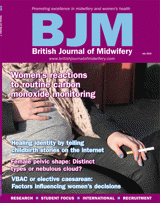References
Vaginal birth after caesarean or elective caesarean—What factors influence women's decisions?
Abstract
Background:
Vaginal birth after caesarean (VBAC) is a safe option for most women. In the UK, just over 50% of women with a previous caesarean section opt for a VBAC and repeat caesarean is one of the four main causes of the rising caesarean rate. It is therefore important to review the literature in order to explore the factors which influence women's decision-making, which may increase normal birth rates.
Method:
A literature search was conducted using Ovid Online and EBSCOhost database platforms. Primary, qualitative, peer reviewed, English language research papers were assessed according to inclusion/exclusion criteria.
Results:
Nine primary research studies were found. The findings were synthesised into five themes: personal beliefs about birth, previous birth experience, the need for control, health professionals and practical considerations.
Discussion:
The influence of women's beliefs about birth, as well as the attitudes of health professionals were identified as the main factors that influence women's decision-making with regards to VBAC. It is important for practitioners to reflect on their own way of communicating with women about VBAC to increase perceived supportiveness and women's autonomy. Further research is required to better understand the psycho-social aspects of decision-making.
Conclusion:
Knowledge of the identified themes will give health professionals an insight into the inner ‘lived’ experience of women making decisions regarding VBAC, increasing their awareness of their potential influence on a woman's final decision when planning her birth. The factors found may also be able to be applied to other areas of women's decision-making in maternity care.
Improving women's choice and control over their maternity care has been on the political agenda in the UK for over 20 years (Department of Health, 1993). An area where the issue of women's choice is regularly encountered is the choice of vaginal birth after caesarean (VBAC) (Hamilton, 2009). Key midwifery textbooks (Hamilton, 2009; Meakin, 2012) devote only a few paragraphs to VBAC, terming it ‘trial of scar’ and solely discussing success rates and risk factors. Downe (2008) describes this occurrence as the ‘primacy of risk’ in maternity care, with risk being the foremost concern—the main risk of VBAC being uterine rupture (Hamilton, 2009). However, this is a 0.21% risk (Fitzpatrick et al, 2012) and when balanced against the morbidity associated with multiple caesarean sections (Silver et al, 2006), VBAC is considered a safe and valid choice (Guise et al, 2010). Paré et al (2006) discovered that for women who want to give birth to at least two more children, VBAC is associated with better long-term outcomes, recognising the long-term reproductive consequences (including the chance of hysterectomy for uterine rupture and placenta accreta) of multiple caesarean sections.
Register now to continue reading
Thank you for visiting British Journal of Midwifery and reading some of our peer-reviewed resources for midwives. To read more, please register today. You’ll enjoy the following great benefits:
What's included
-
Limited access to our clinical or professional articles
-
New content and clinical newsletter updates each month

